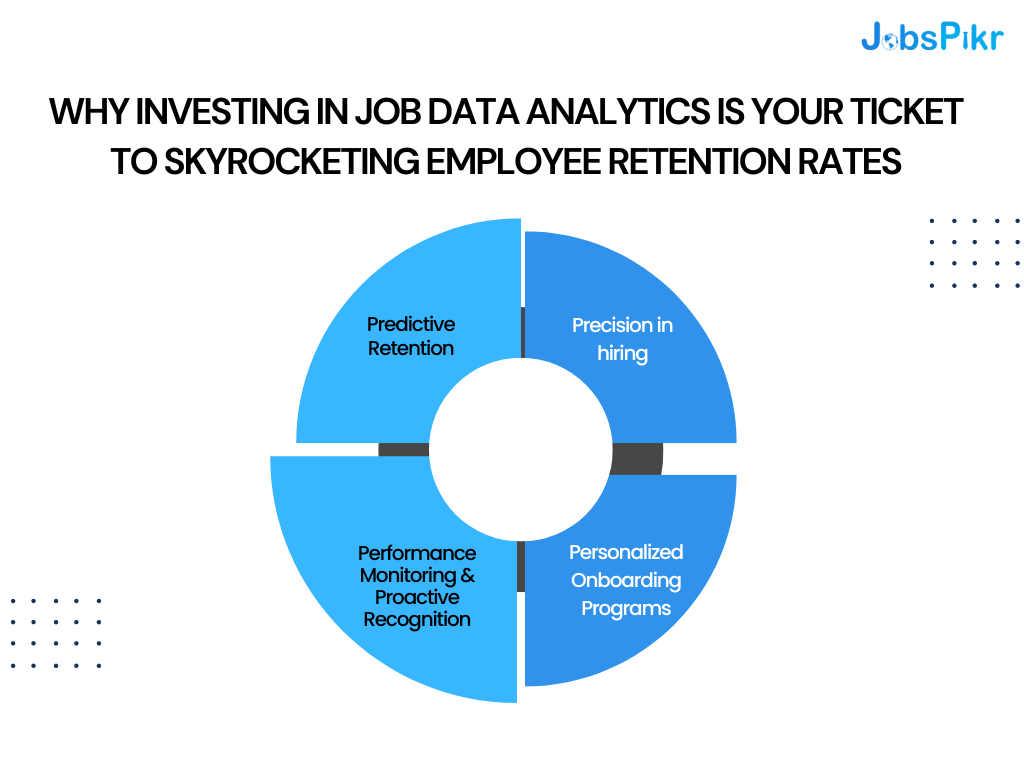One of the most significant yet underlooked expenses for any company is recruiting talent. The recruitment process starts with advertising the role, spending time going through endless resumes, interviewing the shortlisted candidates, and then onboarding the right ones. But the expenses and efforts don’t just end there. Once the candidate has been onboarded, the company then invests money in training them to be a valuable resource.
After all this time and resources spent, if the employee ultimately decides to resign within a few months, it can be a highly disappointing situation for any company. This is why implementing employee retention strategies from the start is a must for long-term success. As companies seek to cultivate a work environment that fosters loyalty, the need for job data analytics becomes imperative. These analytics can help predict reasons for employee attrition so you can take the right steps before the situation becomes too critical.
Here’s why investing in job data analytics is your ticket to skyrocketing employee retention rates:

Precision in hiring:
Hiring without identifying the skill gaps in your workforce can only lead to an accumulation of mediocre talent who doesn’t excel in their roles. With data-driven recruiting, companies set themselves up for success right from the start.
For instance, Jobspikr’s automated skill matching and powerful search capabilities help companies pinpoint their ideal candidates with laser-like precision. Whether it’s filtering by skills, experience, or location — its AI-driven algorithms improve the accuracy of candidates that match a certain role’s job description.
By zeroing in on the right candidates from the get-go, you can ensure that they are clear about their roles and will be a right fit for the company.
Personalized Onboarding Programs:
Once you have found the right talent, the next step is onboarding and training them to be a valuable addition to the company’s growth. Job data can help tailor onboarding programs to meet the specific needs and preferences of new hires.
- Job data analytics are valuable in identifying skills that are critical to the organization’s current and future success. It also sheds light on emerging industry trends. Powered with this data, hiring managers can design training programs that align with industry trends and ensure employees have the skillset required to meet business goals.
- It also helps in a creating personalized onboarding experience that fosters a sense of belonging and improves the overall employee experience. This is a very important step in making an employee feel valued and empowered to succeed.
Performance Monitoring & Proactive Recognition:
Recognizing a mismatch in employee expectations and current experiences is vital in reducing employee attrition rates. For instance, if the performance data for a certain team suddenly decreases, it may be a reason for concern. The reasons could vary from extreme work pressure to lack of support from the manager or even lack of recognition.
Data derived from employee engagement surveys enable companies to monitor employee performance. It can also help identify high-performing employees and also pinpoint if their performances have dipped. In such situations, help can be offered in time to rectify the situation and make employees feel supported.
Recognizing and rewarding employee contributions is another way to foster a positive work environment and promote employee retention. By implementing data-driven recognition programs and incentive structures, companies can increase employee satisfaction and loyalty.
Predictive Retention:
But wait, there’s more! The magic of job data analytics doesn’t stop there. Utilizing job data analytics, companies can proactively identify potential retention issues and take the right steps to address them. Let’s say the labor market trends show that there is an acute shortage of candidates equipped with a certain skill set. In such a situation, how do you find the right employee and ensure they stick around for the long haul?
Job data analytics like labor market trends not only help businesses identify high-demand and short-supply skills but also take the proper steps to give their employees what they want. For instance, the organization can implement remote work flexibility to secure talented individuals across borders. It can also invest more in training candidates who possess certain matching skills but are still not 100% fit for the role.
Google’s Strategic Move: Reducing New Mothers’ Turnover Rate
With the help of cutting-edge job data analytics, companies can analyze industry standards for employee benefits, crafting compelling compensation packages to boost employee retention. For instance, let’s look at what Google did when it identified a concerning trend – new mothers were leaving the company at a higher-than-average rate.
Google embarked on a data-driven journey to uncover the root cause of this issue. Through careful analysis of workforce insights, exit interviews, and retention metrics, Google uncovered that their existing paid maternity leave policy makes it difficult for new mothers to adjust to their new role. This compels them to quit the company as they need more time off to bond with their newborns.
Armed with this data, Google recognized the opportunity to enact meaningful change and improve employee retention. In a bold and progressive move, Google revamped its paid maternity leave policy, extending it from 18 weeks to 24 weeks.
Two important aspects come to light here. Firstly, Google must have a deep understanding of the value each of these new mothers has delivered to the company over the years. Secondly, the expenses the company had incurred in the recent past to find replacements for these new mothers.
By using job data analytics to revamp its paid maternity policy, Google reduced the number of new mothers quitting significantly and created a more family-friendly workplace culture. The impact of this policy change was profound as it boosted employee morale and engagement across the organization. New mothers felt valued and supported, leading to increased loyalty and retention.
Google’s approach serves as a powerful example of the transformative potential of decision-making driven by job data analytics in shaping employee retention strategies. This leads us to the conclusion that qualified job data is a valuable asset for enhancing employee retention efforts across the entire employee lifecycle.
And if you’re looking for a reliable partner for qualified job data analytics for your business, reach out to the experts at JobsPikr today! No matter your industry, company size, or domain, we offer data to fuel your business and spark new solutions. Schedule a demo by writing to sales@jobspikr.com



